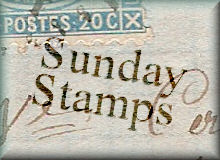Mist Fantasy
The Group of Seven, also known as the Algonquin School were a collection of painters from 1920-1933 inspired by the Canadian landscape and are considered the first truly Canadian art movement. I start with JEH MacDonald who in 1918 travelled to Algoma, Ontario in a specially outfitted rail-road car that functioned as a mobile studio, he was to return many times in Autumn in this carriage.
Isles of Spruce
Arthur Lismer (1885-1969) was born in England but studied art in Antwerp, Belgium emigrating to Canada in 1911 where the wilderness of the country took hold of him and he painted it for the rest of his life. Big Raven
The Group of Seven were definitely a male club so Emily Carr was never a member but as Groucho Marx said "I don't care to belong to any club that would have me as a member" she is always closely associated with them. Like all great artists her work continually changed and developed into this post impressionist style.These are all stamps issued in the 1970s but this was not the first time the Group of Seven appeared on Canadian stamps for the 1967 definitive series encompassed scenes from paintings issued in a mono colour rather than the vibrant originals
Left to right, Alaska Highway by AY Jackson, The Jack Pine by Tom Thompson (which has left Canada briefly to be displayed in the Dulwich Picture Gallery in London until January). He died in 1917 but the Group considered him a founder. Lastly Bylot Island by Lawren Harris who favourite subject was the Canadian north and Arctic. He painted this scene many times continually simplifying, he stopped signing and dating his works wanting to be judged only on merit. He probably epitomises the Group of Seven and their meaning to Canadian. As Christianne Wilhelmson says
“If you grow up in Ontario, as I did, the Group of Seven are simply a part of your being – I think they put something in the water! In fact, I don’t remember a time when I didn’t know who they were, their importance to the development of Canadian identity and been able to list many of the members. It wasn’t just that names and dates were pounded into our heads in history or art classes, but rather that what they managed to capture could be seen out the window of our car as my family made its way north to visit relatives. More than once I heard someone say, ‘it feels like we’re in a Group of Seven painting.’Bylot Island in colour and the rest of this short meditation here . Lastly I finish as I started with McDonald painting away in his railroad car the mountain landscapes of Canada.
including his acclaimed "The Solemn Land"
An entry to Sunday Stamps whose theme this week is Art






7 comments:
Joy, this is a very informative post. I'm delighted to find that I have the Bylot Island stamp.All the stamps are impressive.
That is an interesting group of artists I had never heard of. The kind of art history taught and art shown in museums here does not include Canadians. Actually, it usually doesn't even include U.S. artists who did anything less than what art historians consider most important.
Thank you for including the link to the color image of Bylot island. What a wonderful painting. thank you for participating.
Havent heard of this Group of artists before but they did tickle my curiousity. The stamps are lovely, and Wilhelmson's quote tells a lot in just a few words, when something is so common in your every day life that you just end up feeling it is an inherited part of you
These stamps bring back memories. In the 1980s I gave away my stamp collection to someone I thought might appreciate them more than I did at the time. I wonder what happened to them.
I hadn't heard of these artists, so thanks for sharing.
The Group of Seven are new to me too, but I wish I had come across them before. Their work is beautiful.
Post a Comment